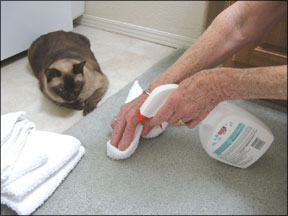One of the most frustrating feline behaviors that cat lovers endure is urination outside the litter box. In some cases, the cat has issues with the box. Cats may select litter materials or locations based on their own convenience, disregarding any resulting inconvenience to the people who share their household. Fortunately, with a bit of detective work and perhaps some

Bev Caldwell
288
flexibility on the part of the family, most litter box issues can be resolved.
The cat that uses his litter box regularly – yet deposits additional urine in assorted areas – is a cat of a different color. When such behavior occurs, the first consideration should be that the cat might be ill. A thorough examination with urinalysis is in order. Confirm that the cat has been neutered. Cats adopted late in life might require a blood test for added assurance.
If the cat in question has been neutered, has received a clean bill of health and continues to use his litter box on a regular basis, then what else could be driving him to urinate outside his box?
Actually, we should probably be wondering why more cats dont urinate all around the house. Urination on multiple vertical surfaces, known as urine marking, is a popular pastime for free-roaming cats. The behavior serves a communicative function, allowing cats to send and receive messages that are undoubtedly important.
Occasionally, cats seem to expect their humans to understand the notes on the urine message board. Naturally, when something valuable is stained with urine, it is difficult for us to be understanding. Yet by at least attempting to interpret the message, we might be able to reduce a cats tendency to mark.
Lets give it a try. Suppose that you feed your cat every morning at 7:00 a.m. This week, you have decided to use the treadmill before serving breakfast. Each morning, when you finally get to the kitchen, you discover a spritz of urine on the food preparation area of the counter. The message is loud and clear: “Feed me first.”
Some messages are harder to decipher. What should you think when you discover urine on a personal item, such as your favorite chair? Consider whether there have been any changes in your relationship with your cat. Have you been unusually angry or distressed? Have you taken on a job that involves handling other cats? Cats have even been known to urinate on personal items in response to a persons illness.
Cats may also urinate on personal items due to anxiety associated with being alone for extended periods. When the behavior occurs exclusively during departures, and particularly if it happens during most departures, separation anxiety is the likely diagnosis.
Just as a cat may urinate on the belongings of a household human, he may also urinate on the bedding or favorite resting place of another household cat. Again, look for signs of friction in the relationship. Be sure that the cat is not responding to the illness of his companion. Early illness may result in very subtle behavior changes or even odors that a human may not detect.
Unpleasant odors may be the culprit when urine is discovered in areas of the house that have been refurnished, painted, freshly scrubbed or newly carpeted. Cats may mark in order to make treated areas smell more familiar to them. And using an air freshener to mask pet odor can backfire if the cat finds the freshener to be aversive and urinates to apply a “pleasant” scent. In such a case, responding with another air freshener can lead to escalation on the part of the cat. And so it goes.
In some cases, the source of the odor is outdoors. When urine is discovered along windows and outside doorways, look for an enemy cat in the garden.
Finally, some very normal cats with no issues at all begin to mark as they mature socially. Cats are considered to be mature at about two or three years of age. With maturity comes the confidence to declare, “I live here.” These urine marks are likely to be found along central, frequently used pathways of the home.
Your cat is not urinating to punish you. Consider the location of the urine marks. Try to eliminate triggers. Use nontoxic repellents to keep outside cats from getting too close for comfort. Use extra playtime to reduce stress for you and your cat. When you are away, prepare a movie or a kitty hunt to keep your cat occupied. And if nothing you try works, call a behaviorist or your veterinarian.



